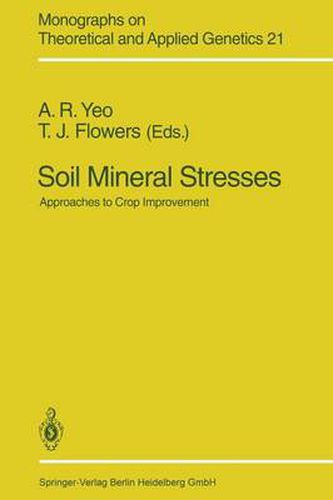Readings Newsletter
Become a Readings Member to make your shopping experience even easier.
Sign in or sign up for free!
You’re not far away from qualifying for FREE standard shipping within Australia
You’ve qualified for FREE standard shipping within Australia
The cart is loading…






This title is printed to order. This book may have been self-published. If so, we cannot guarantee the quality of the content. In the main most books will have gone through the editing process however some may not. We therefore suggest that you be aware of this before ordering this book. If in doubt check either the author or publisher’s details as we are unable to accept any returns unless they are faulty. Please contact us if you have any questions.
Thisbookisconcernedwiththewaysinwhichcropsmightbedevelopedfor soilsthatare,atthepresent,agriculturallyunproductivebecauseofexcesses and/ordeficienciesofcertainminerals. Wehaveconcentratedonsoils,rather thanonenvironmentalconditionsthatlimitproductivity,sincetherehavebeen anumberofrecenttextsdealingwithtopicssuchasdroughtandtemperature. Theaimisthatthoseworkingtoderivecropsforgrowthonthese problem soilsshouldbeawareofthemanydiverseavenuesthatareavailable. These comefromthedisciplinesofplantbreeding,geneticsandphysiology,andthe interfacesthataredevelopingbetweenthem. Thebackground,therequirementstofeedtheprojectedincreaseinhuman population,issetoutintheintroductorychapter. Thenextfivechaptersthen dealwiththeapproachestocropimprovement:themeritsofaconventional breedingprogramme,theimportanceofphysiologicalcharactersinmaking selections,theuseofinvitrotechniques,ofcytogenetics,andthevalueof developingnativeplantsintocropsintheirownright. Althoughsalinityisoften usedasanexample,reflectingtheresearchinterestsofmanyoftheauthors,the methodsandapproachesdescribedhavemuchwiderapplicability. Twochap- tersarethenconcernedmorespecificallywithbreedingfortolerancetoother metaltoxicitiesandwithdeficienciesandtoxicitiesofmicronutrients. Finally,in theconcludingchapter,wesummariseandfindcommongroundbetweenthe differentapproachesandpointsofview. Brighton,April1994 ANTHONYR. YEO TIMOTHY J. FLOWERS Contents Chapter1 Introduction:WorldPopulationandAgriculturalProductivity T. 1. Flowers 1. 1 HowManyPeopleAreThere? . 1 1. 2 AgriculturalRequirements. . 2 1. 2. 1 FoodRequirements…2 1. 2. 2 FoodSupply…4 1. 3 Population-CarryingCapacity…5 1. 4 HowMuchLandIsThere? . 6 1. 5 IncreasingFoodProduction . 7 References…9 Chapter2 ConventionalPlantBreedingforTolerancetoProblemSoils C. N. ChaubeyandD. Senadhira 2. 1 ScreeningTechniques . 11 2. 2 VariabilityinToleranceforSoilStresses . 14 Rice . 15 2. 2. 1 2. 3 GeneticsofToleranceforSoilStresses…16 19 2. 3. 1 GeneLocationandLinkages…CorrelatedChanges…20 2. 3. 2 2. 4 Crop-Improvement . 21 2. 4. 1 Introduction…21 2. 4. 2 PureLineandMassSelection…21 2. 4. 3 HybridisationandSelection. 23 2. 4. 3. 1 PedigreeMethod…23 2. 4. 3. 2 BulkMethod…23 BackcrossBreeding…2. 4. 3. 3 26 2. 4. 3. 4 RecurrentSelection…26 2. 4. 3. 5 RapidGenerationAdvanceProcedures…27 2. 4. 4 MutationBreeding…28 2. 4. 5 PolyploidBreeding. 28 2. 4. 6 HeterosisBreeding. 29 2. 5 Summary…29 References…29 VIII Contents Chapter3 PhysiologicalCriteriainScreeningandBreeding A. R. Yeo 3. 1 Introduction…37 3. 2 ReasonsfortheUseofPhysiologicalSelection . 38 3. 2. 1 TheComplexityofTolerance…38 3. 2. 2 ImportingTolerancefromWildRelatives . 39 3. 2. 3 MeasuringStressTolerance . 40 3. 2. 4 InteractionBetweenEnvironmentalStresses…42 3. 2. 5 LimitationstotheUseofYieldasaSelectionCriterion…42 3. 3 Salinity . 43 3. 3. 1 BasicProblems…43 SaltExclusion…44 3. 3. 2 3. 3. 3 ConditionsRequiringOsmoticAdjustment. . 45 3. 3. 4 CharacteristicsNeededinSalt-TolerantPlants . 46 3. 3. 4. 1 ControlofSaltUptake…
$9.00 standard shipping within Australia
FREE standard shipping within Australia for orders over $100.00
Express & International shipping calculated at checkout
This title is printed to order. This book may have been self-published. If so, we cannot guarantee the quality of the content. In the main most books will have gone through the editing process however some may not. We therefore suggest that you be aware of this before ordering this book. If in doubt check either the author or publisher’s details as we are unable to accept any returns unless they are faulty. Please contact us if you have any questions.
Thisbookisconcernedwiththewaysinwhichcropsmightbedevelopedfor soilsthatare,atthepresent,agriculturallyunproductivebecauseofexcesses and/ordeficienciesofcertainminerals. Wehaveconcentratedonsoils,rather thanonenvironmentalconditionsthatlimitproductivity,sincetherehavebeen anumberofrecenttextsdealingwithtopicssuchasdroughtandtemperature. Theaimisthatthoseworkingtoderivecropsforgrowthonthese problem soilsshouldbeawareofthemanydiverseavenuesthatareavailable. These comefromthedisciplinesofplantbreeding,geneticsandphysiology,andthe interfacesthataredevelopingbetweenthem. Thebackground,therequirementstofeedtheprojectedincreaseinhuman population,issetoutintheintroductorychapter. Thenextfivechaptersthen dealwiththeapproachestocropimprovement:themeritsofaconventional breedingprogramme,theimportanceofphysiologicalcharactersinmaking selections,theuseofinvitrotechniques,ofcytogenetics,andthevalueof developingnativeplantsintocropsintheirownright. Althoughsalinityisoften usedasanexample,reflectingtheresearchinterestsofmanyoftheauthors,the methodsandapproachesdescribedhavemuchwiderapplicability. Twochap- tersarethenconcernedmorespecificallywithbreedingfortolerancetoother metaltoxicitiesandwithdeficienciesandtoxicitiesofmicronutrients. Finally,in theconcludingchapter,wesummariseandfindcommongroundbetweenthe differentapproachesandpointsofview. Brighton,April1994 ANTHONYR. YEO TIMOTHY J. FLOWERS Contents Chapter1 Introduction:WorldPopulationandAgriculturalProductivity T. 1. Flowers 1. 1 HowManyPeopleAreThere? . 1 1. 2 AgriculturalRequirements. . 2 1. 2. 1 FoodRequirements…2 1. 2. 2 FoodSupply…4 1. 3 Population-CarryingCapacity…5 1. 4 HowMuchLandIsThere? . 6 1. 5 IncreasingFoodProduction . 7 References…9 Chapter2 ConventionalPlantBreedingforTolerancetoProblemSoils C. N. ChaubeyandD. Senadhira 2. 1 ScreeningTechniques . 11 2. 2 VariabilityinToleranceforSoilStresses . 14 Rice . 15 2. 2. 1 2. 3 GeneticsofToleranceforSoilStresses…16 19 2. 3. 1 GeneLocationandLinkages…CorrelatedChanges…20 2. 3. 2 2. 4 Crop-Improvement . 21 2. 4. 1 Introduction…21 2. 4. 2 PureLineandMassSelection…21 2. 4. 3 HybridisationandSelection. 23 2. 4. 3. 1 PedigreeMethod…23 2. 4. 3. 2 BulkMethod…23 BackcrossBreeding…2. 4. 3. 3 26 2. 4. 3. 4 RecurrentSelection…26 2. 4. 3. 5 RapidGenerationAdvanceProcedures…27 2. 4. 4 MutationBreeding…28 2. 4. 5 PolyploidBreeding. 28 2. 4. 6 HeterosisBreeding. 29 2. 5 Summary…29 References…29 VIII Contents Chapter3 PhysiologicalCriteriainScreeningandBreeding A. R. Yeo 3. 1 Introduction…37 3. 2 ReasonsfortheUseofPhysiologicalSelection . 38 3. 2. 1 TheComplexityofTolerance…38 3. 2. 2 ImportingTolerancefromWildRelatives . 39 3. 2. 3 MeasuringStressTolerance . 40 3. 2. 4 InteractionBetweenEnvironmentalStresses…42 3. 2. 5 LimitationstotheUseofYieldasaSelectionCriterion…42 3. 3 Salinity . 43 3. 3. 1 BasicProblems…43 SaltExclusion…44 3. 3. 2 3. 3. 3 ConditionsRequiringOsmoticAdjustment. . 45 3. 3. 4 CharacteristicsNeededinSalt-TolerantPlants . 46 3. 3. 4. 1 ControlofSaltUptake…